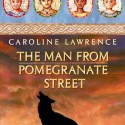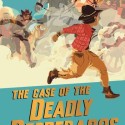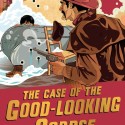In Conversation with Caroline Lawrence – Part I

Back last summer I had the wonderful opportunity to interview Caroline Lawrence, author of The Roman Mysteries, in person. Not only that; I was also given a tour of some of Caroline’s favourite Roman artefacts in the British Museum, some of which influenced her writing. Read part 2 here – you could win copies of the first two books in the P.K. Pinkerton Mysteries.
Rhys: My first question was about the religious elements in both series. You’ve got, what? St Paul…?
Caroline: I’ve got St John the Evangelist in the penultimate book in the Roman Mysteries, The Prophet from Ephesus. It seemed amazing that he was still alive in 81AD, but he was the youngest disciple. That penultimate Roman Mystery was the most evangelistic because three of the four characters convert. Of course, I can’t have them all convert!
R: Flavia doesn’t convert, does she?
C: No she doesn’t, but – you know – she’s surrounded by believers…
R: So she will at some point!
C: She will, yes!
R: Why did you choose to convert everyone but Flavia?
C: Maybe because Flavia is most like me, and I’m going through a slight questioning phase myself at the moment.
R: At the moment, or?…
C: At the moment, yeah, it’s kind of up and down.
R: I think it’s always like that.
C: Yes. And I think because Flavia is the real thinker – the truth seeker – she might be the last one to go, to convert that is. Now Nubia… I loved the idea that animal-loving Nubia would convert because Jesus did away with sacrifice. There was so much sacrifice in the roman world, the ancient world, and Christianity just did away with it in one stroke. Suddenly there was no more sacrifice, yet there were all these institutions geared to sacrifice. At the moment I’m working on the Roman Mystery Scrolls a Roman Mysteries spinoff, and the third one is about the thunder omen. My hero Threptus has a soothsayer mentor. Now, there are two words for the soothsayer, one is augur (they look at signs like lighting and birds and tell us what the gods are saying through those) and the other word is haruspex, which literally means a “gut-gazer”. Those are the soothsayers that cut up the animals and nose around in the entrails, look at the liver. The only problem is, that Threptus’s mentor faints at the sight of blood. Not a good thing if you are a “gut-gazer” or even if you lived in Ancient Rome. Every day in Rome or any Roman city, there would have been thousands sacrifices, blood, animals killed. And then you ate them.
R: Oh, they eat them? I thought they just left them.
C: No, you eat them! That’s why there’s so much in the New Testament about whether believers could eat meat that’s been sacrificed to other gods. Presumably butchers would buy the meat, if they didn’t pass it around to the people hanging around the sacrifice, you know – “we’re celebrating the Saturnalia”, so they had pork kebabs two hours later. If they didn’t give parts of the sacrifice to the public, they might have sold it to a butcher. Also the priests would take their portion and they’d burn the inedible bits as a sweet smell for gods. But there would be a whole animal, and they used every bit. They wouldn’t just dump it. Everything was worth something…I can’t think of one element that you wouldn’t use – even the icky bits would be cut up and put in a sausage. It’s enough to make you become a vegetarian! I often think that before it was destroyed, the temple of Jerusalem must have had gutters just running with blood, especially on Passover when every family brought their own sheep to sacrifice.
R: Yeah – I really liked how you incorporated that element with Jonathan…I mean, in an RE lesson 5 years letter I know – “the sacking of Jerusalem”.
C: Yes, I just thought it was such an interesting period.
R: It is – I especially liked Jonathan’s reaction to it…because you kind of hint at it in previous books but then in one of them you really revisit what happened. It’s in one of the later ones, I think.
C: Oh- the flashback of the sacking of Jerusalem? Yes, that’s probably The Slave Girl of Jerusalem you’re thinking of: Hephzibah’s memory. And then she survives Masada which was about 3 years after the sacking of Jerusalem… that’s so fascinating that the Colosseum was built with spoils of the sacking of Jerusalem. It was opened in 81AD with 100 days of inaugural days–
R: Which is in the book.
C: Yes, and Jerusalem was sacked in 70AD, which, by the way, was 40 years after the crucifixion of Christ. And in Jewish thought, 40 is always a symbolic number. There are the 40 years in the wilderness and the 40 days in the desert when Jesus is being tempted… it’s a time of ‘get it right’ because then the reckoning comes. (By the way, Jesus probably wasn’t sacrificed in 33AD, but rather in 30AD because he was born in 3BC. It’s amazing how it all ties up.) So the Romans sacked Jerusalem with Titus as the general in charge, and they brought all this gold back to Rome. In fact, they’ve just found evidence that the Arch of Titus was painted. It was erected after his death by his younger brother Domitian and it shows Roman legionaries taking booty from the temple. One of the objects they carry is the Menorah, the big gold candelabra. Archaeologists have just discovered it was painted deep yellow to show it was gold. (It’s a well-documented fact that the Romans painted their monuments and sculptures). Anyway, they built the Colosseum with Jewish slave labour and funded it with the spoils of the Temple.
R: It’s quite ironic.
C: Yes! The Colosseum, essentially, was built because of the sack of Jerusalem, with the labour and the money. This was the place where many Jews and Christians were thrown to beasts. That would have been the lunchtime punishment section of the games program!
R: Quite a nice tying up with the London Olympics, there!
C: I find the program of events at a day at the Colosseum fascinating. You’ve got your morning for the beast fights, then at noon people stayed in their seats for lunch – often with a packed lunch of olives and cheese – so they could watch the criminal executions. Finally, the day’s big event were pairs of gladiators in the afternoon: but man-on-man, not big melee. And they’d build those up to the big event, I think, between the two gladiator superstars of the day.
R: Because in Gladiators of Capua, you have the Colosseum flooded
C: Scholars think it could have been flooded when it was first built but when this proved impractical Domitian got rid of the flooding capability. I talked to the world expert on the Flavian Arena (as it’s known) Kathleen Coleman is a Classics professor at Harvard University and world-renowned scholar. One of her fields of expertise is the Colosseum in the Flavian period. She kindly read The Gladiators from Capua and gave me notes on it. (She also consulted for the film Gladiator, but in the end they did their own thing!)
R: It’s a great film, but it’s a little grim – when you think about it it’s a revenge story.
C: Yeah, it’s always really grim. Revenge is always a really dark motive for a hero though it often does work.





What did you think about In Conversation with Caroline Lawrence – Part I?